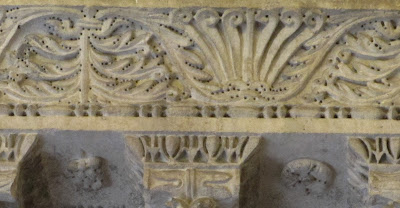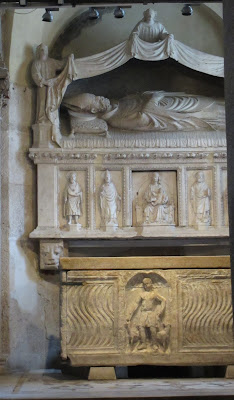Diocletian
Diocletian was born in 244 in the vicinity of Salona (near modern Split, Croatia) and became Roman Emperor in 284. In 285 he appointed Maximian Augustus as co-emperor. In 293 he appointed Galerius and Constantius as Caesars, or junior co-emperors, and they became known as the "tetrarchy," or rule of four. Diocletian initiated empire wide persecutions of the Christians in 303 which continued until 311, well after he stepped down as emperor. He stepped down as emperor on May 1, 305, the only Roman emperor to voluntarily do so. He then retired to his palace in Split where he died on December 3, 311, possibly by suicide, after his carefully orchestrated succession plan completely fell apart.
 |
| Diocletian |
Diocletian's Palace
The palace was built between 295 and 305. It was rectangular in shape, enclosed by walls with watchtowers and large gates in the center of each wall. It was built primarily of white limestone and marble. The southern gate faced the Adriatic Sea and at that time was right on the water. This was probably Diocletian's entrance or a service entrance. Diocletian's apartments, both public and private, were against the southern sea wall and were built on a substructure of subterranean vaults which were used to make the south end the same level as the north end, compensating for the sloping terrain. In addition to Diocletian's apartments, the southern part of the palace contained Diocletian's mausoleum and the temple of Jupiter. The northern part of the palace was a residential complex housing soldiers and servants. The palace could hold more than 9,000 people. The eastern gate was known as the Silver Gate, the western gate as the Iron Gate, the northern gate as the Golden Gate and the southern gate as the Bronze Gate.
 |
Artist rendition of Diocletian's palace.
|
Jupiter was the king of the Roman gods (the equivalent of the Greek Zeus) and the god of sky and thunder. He is identified by the thunderbolt and his sacred animal is the eagle. There was a temple to Jupiter on the Capitoline Hill in Rome where Roman emperors sacrificed white oxen and lambs to Jupiter (white animals were offered to deities of the upper world and each deity had his own preference for animals) and triumphant generals honored him with their spoils. The sacrificial animal's head had wine and sacred bread (made of flour and salt) sprinkled over it. The sacrificial animal was then stunned with an axe or mallet, then disemboweled and its innards inspected to make sure that the god was not offered a bad omen. The animal was then killed by having its throat cut. The most important organs of the animal were then burnt on the altar. The carcass was cut into pieces and eaten on the spot, or laid aside. Then the priest, wearing a mask or blindfold, to shut out evil influences, would whisper prayers while a flute played to drown out ill-omened noise.
Diocletian built a Temple to Jupiter in his palace, opposite his own tomb, and within sight across the peristyle down a narrow alley. The main room, or cella, would have housed an image of Jupiter and perhaps a small altar for incense or libations. Behind the cella was a room used by temple attendants for storage of equipment and offerings. The steps and front entrance to the temple were known as the porch and it was fronted by columns The public religious ceremonies took place outside and not within the cella. Sacrifices of animals would take place at an open-air altar in front of the cella.
 |
| Artist rendition of the Temple of Jupiter. Note the front has columns. |
 |
| Artist rendition of Temple of Jupiter. Note open-air columns in front of cella. |
 |
| This headless sphinx is from the time of Diocletian, although it would not have been placed there. |
Some Roman emperors promoted the idea that they themselves were gods. Diocletian was more conservative then many of them and his own identification with Jupiter was probably more an expression of the fact that as emperor he was used as the supreme instrument of Jupiter's will.
St. John's Baptistery
In the late Roman Empire or Middle Ages, the Temple of Jupiter was turned into a Cathedral baptistery and the crypt beneath it was consecrated to St. Thomas. The base of the temple covers the crypt and the vaulted ceiling of the crypt is the floor of the baptistery . The interior contains a baptismal font from the 12th century in the shape of a cross. One of the carved panels show a Croatian ruler, sitting on his throne in his headware with a figure to the bottom left bowing before the ruler in supplication and a third figure, according to Rick Steves, a bishop, standing on that figure's back. According to Steve's, this sums "up the social structure of the Middle Ages." A half-barrel vaulted ceiling is above, with each panel being unique. A modern sculpture of John the Baptist by Ivan Mestrovic replaces a statue of Jupiter that once was in the same spot. Two Mediaeval stone coffins, one inside and one outside, contain the remains of Split archbishops John and Luca.
The mausoleum of Diocletian is in the eastern part of the peristyle, which is the central open-air area of the palace. It has an octagonal shape and is encircled by 24 columns that supported the roof. It has a round interior with two rows of Corinthian columns and a frieze. The only items inside that remain from the mausoleum are the granite columns, the relief circling the base of the dome (showing the greatness of Diocletian) and some red pillars around the top of the pulpit that came from the sarcophagus.
 |
| Artists rendition of the mausoleum. |
 |
| The mausoleum from artistic rendition. |
 |
| The mausoleum is in the center. The choir is attached to the left and the bell tower is attached to the right. |
 |
| Gray stone columns and reliefs are original to the mausoleum. |
 |
| Reliefs are original - from the life of Diocletian. |
 |
| Red pillars around the top of the pulpit came from Diocletian's sarcophagus. |
Cathedral of Saint Domnius
About three miles from Diocletian's palace was the city of Salona, the capital of the Roman province of Dalmatia. Salona was destroyed by invasions of the Avars and Slavs in the 6th and 7th centuries and refugees from Salona settled inside the remains of Diocletian's palace. They brought with them their Christian religion. One of their martyrs was the Bishop of Salona, Domnius, who was beheaded in 304 as part of the persecutions of the Emperor Diocletian. They chose St. Domnius to be the patron saint of Split. In 650, John of Ravenna converted the mausoleum to a church and consecrated it to the Virgin Mary. John's sarcophagus is one of those now at the baptistery. Split was promoted to an archdiocese around 925. A bell tower was then built in 1100 and later extensively rebuilt in 1908. Two large wooden doors with 14 scenes from the life of Christ were installed on the portal of the cathedral (the mausoleum) in 1214. On August 23, 1217, King Andrew II launched a crusade from Split. Finally, in the 17th century, a choir was added to the eastern side of the mausoleum which required that the eastern side of the mausoleum be removed. These elements now constitute the Cathedral of Saint Domnius, the seat of the Archdiocese of Split-Makarska, the oldest (and probably smallest) cathedral in the world.
 |
| Smaller choir hooks into the octagonal mausoleum. |
 |
| Bell tower connects to the mausoleum. |
 |
| Inside the choir. |
 |
| Altar, between the choir and the mausoleum. |
 |
| Close-up of altar. |
 |
| Beautiful marble at base of the altar. |
 |
| Old carved stone. |
The sarcophagus of St. Domnius is to the right of the altar. To the left of the altar is the altar of St. Anastasius, who was martyred (drowned in 302). He is lying on a millstone that is tied to his neck. The relics of St. Domnius now lie in a silver reliquary above a stone relief showing Domnius being beheaded.
 |
| Smaller bells outside the old mausoleum |
Peristyle
 |
| Underground vault. |
 |
| Underground vault. |
 |
| Underground vault. |
 |
| Underground vault. |
 |
| Ceiling in underground vault. |














































































Excellent details. One of my favorite things about this site is how the Christians took it over in an "in your face" kind of a way. Talk about sweet revenge. (Not very Christian-like, was it?) The whole thing is amazingly well-preserved, and rather than a museum-like ruin, it is full of real life business, almost like a modern-day shopping mall.
ReplyDeleteThose Mestrovic hands are amazing! I especially like the John the Baptist. The colorful marble at Saint Domnius is especially beautiful.
ReplyDeleteI'm glad you were able to talk Judy into leaving her bodyguards behind. Unless they know how to wash dishes and gas up the car, they'd be rather annoying after awhile.
The God of Abraham, Issac and Jacob moved into Jupiter's space 6 century. How fitting.
ReplyDelete